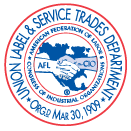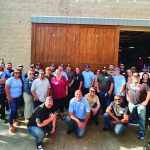 On Labor Day 2013, dignitaries will cut the ribbon on a new $12 billion bridge linking San Francisco and Oakland. It will be a bittersweet ceremony marking the end of a project that employed hundreds of union construction workers under the terms of a Project Labor Agreement. But, the steel assembly for the 52-story building in the center of the bridge and all the decking is a made-in-China product, floated across the Pacific on a barge for U.S. workers to piece together. All the steel on the bridge is Chinese.
On Labor Day 2013, dignitaries will cut the ribbon on a new $12 billion bridge linking San Francisco and Oakland. It will be a bittersweet ceremony marking the end of a project that employed hundreds of union construction workers under the terms of a Project Labor Agreement. But, the steel assembly for the 52-story building in the center of the bridge and all the decking is a made-in-China product, floated across the Pacific on a barge for U.S. workers to piece together. All the steel on the bridge is Chinese.
“What happened here is a shame,” declared Dick Zampa, a retired Iron Worker and former Secretary-Treasurer of the California Building Trades. Zampa
says the Building Trades had lobbied as far back as the 1980s with then California Gov. Gray Davis to secure a made-in-the-USA requirement for bridge construction. When George H.W. Bush was elected in 1988, all that was swept aside.
Initially damaged in the 1989 Loma Prieta earthquake, California lawmaker authorized work to begin on the bridge in 1996. At the behest of then Gov. Arnold Schwarzenegger, the state bypassed the federal Buy American requirement and contracted with the Chinese who formed a partnership with American Bridge and the Fluor Company.
The rationale for going to the Chinese, according to congressional testimony by American Bridge CEO Robert Luffy, was that there is no one U.S. steel company capable of producing a sufficient quantity for the project. There were, however, several U.S. companies willing to form a consortium to meet the challenge. Luffy told a congressional hearing in 2007 that the decision to select the Chinese bid was because it would be cheaper and the company
that won the bid had 32,000 people working in the one facility whereas there was no one U.S. steel firm that could fabricate sufficient steel to get
the job done.
No one thought to ask Luffy to explain why, when the Chinese steel workers made roughly $16 a week, for working six days a week and 16 hours a day to produce the steel for the California bridge, that the state was only going to save approximately 3 percent on the total cost of the bridge.
Schwarzenegger claimed that sourcing the steel in China would save the state $400,000 million. If that estimate was true (and no one can really confirm it) on a $12 billion project, that figures to be less than 3 percent of the overall cost. Clearly, the estimate doesn’t factor in the positive economic impact that the work would have on the region, the state and nationwide if U.S. workers could have fabricated the thousands of tons of steel components for the eight-mile long bridge. The U.S. lost millions in income taxes, social security contributions and the entire economy lost the spending that decent steel manufacturing wages generate.
Furthermore, when initial inspections found that some 65 percent of the welds by the Chinese fabricators didn’t meet specifications, Schwarzenegger had to send 200 engineers and contractors from the California Department of Transportation for an extended stay in Shanghai to scrutinize the work.
As investigative reporters Donald L. Barlett and James B. Steele commented in a report published in mid October 2011:
“By creating jobs for Chinese steelworkers, today’s politicians are making it all but certain that the American steel industry will get even weaker. If it is an industry in which no one company today is capable of doing the work itself, then after another Bay Bridge or two, not even multiple U.S. companies will be able tackle such undertakings. The blue-collar workers will be followed out the door by the white-collar professionals, the engineers and draftsmen, as is already happening.”
Once upon a time, U.S. construction workers assured themselves that they, perhaps alone among U.S. workers, hold skills that cannot
be outsourced. That’s no longer true today. As Zampa points out, at one time crews of Ironworkers and Boilermakers once built container cranes in ports like Oakland from scratch on the spot with domestic steel beams. Now those cranes come in on Chinese barges for assembly by small crews of U.S. Ironworkers.
According to Barlett & Steele, China Construction Company, a firm wholly owned by the Chinese government, has been hard at work on public works projects in the U.S. And, although they are using U.S. construction workers, the profits don’t go to U.S. firms, they go back to China.
China Construction built the Lake Marion High School and Technology Center in right-to-work South Carolina. The same company built the convocation center at the University of South Carolina in Aiken. China Construction is working well beyond the right-to-work South. They are also performing a major renovation on the Alexander Hamilton Bridge between Washington Heights and the Bronx in New York City and the new train station at New York’s Yankee Stadium.







